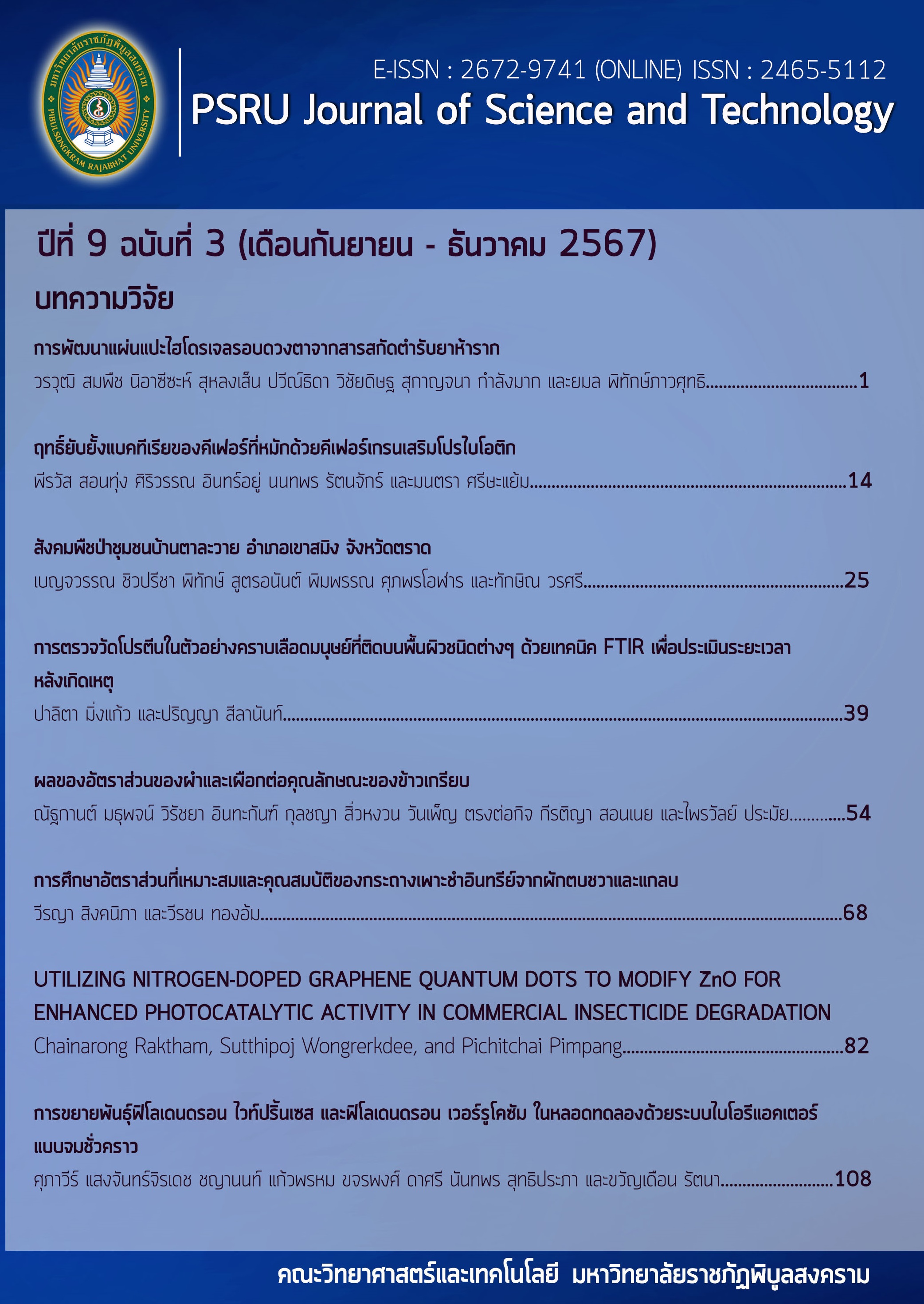IN VITRO PROPAGATION OF PHILODENDRON ERUBESCENS 'WHITE PRINCESS’ AND PHILODENDRON VERRUCOSUM L. MATHIEU EX SCHOTT BY TEMPORARY IMMERSION BIOREACTOR SYSTEM (TIBS)
Keywords:
Propagation, Liquid culture system, PhilodendronAbstract
This study aims to propagate Philodendron erubescens 'White Princess’ and P. verrucosum using a Temporary Immersion Bioreactor System; TIBs. The experiment was designed using a Completely Randomized Design; CRD, and sterile young shoot explants of both cultivars were cultured in Murashige and Skoog (MS) liquid medium supplemented with 0, 1, and 2 mg/l
6-Benzyladenine (BA) was investigated. Feeding was conducted every 6 hours for 5 minutes, compared to a control group cultured in semi-solid MS medium without plant growth regulators over 8 weeks. It was found that a higher percentage of survival and shoot formation of P. erubescens 'White Princess’ cultured in the TIBs system was observed in all liquid media formulations than the control. The highest average number of shoots (3.10 per explant), and shoot height (5.50 mm) was found in the liquid MS medium without growth regulators in the TIBs. Furthermore, the highest average number of leaves (4.20 leaves) and roots (1.60 roots) could be obtained when young shoots of P. verrucosum were cultured in the TIB system with liquid media supplemented with 1 mg/l BA whereas the longest shoot length (16.20 mm) was received on the medium added with 2 mg/l BA. Plantlets of both species were transplanted into externally acclimatized in the greenhouse using three different planting materials: peat moss, a peat moss-perlite mix (4 : 1), and a peat moss-vermiculite mix (4 : 1) for 4 weeks. The results indicated that Both plantlet species exhibited a 100% of survival rate. However, the highest average plant height of both species was found when a mixture of peat moss-perlite (4 : 1) was used as planting material. The results of this study can be applied to the propagation of other species in the Philodendron genus to produce large quantities in a short period, providing commercial benefits.
References
กิตติศักดิ์ โชติกเดชาณรงค์. (2563). การขยายพันธุ์หญ้าหวานโดยการเพาะเลี้ยงเนื้อเยื่อในระบบแช่ชั่วคราว. วารสารวิทยาศาสตร์บูรพา, 25(1), 313-325.
ครองใจ โสมรักษ์. (2019). ผลของสีฝักและวัสดุปลูกต่อการงอก และการเจริญเติบโตของต้นกล้าครามฝักงอ. วารสารเกษตรพระวรุณ มหาวิทยาลัยราชภัฏมหาสารคาม, 16(2), 375–386.
ดลยา หนูแก้ว, ณัฏฐ พิชกรรม, และพูนพิภพ เกษมทรัพย์. (2554). การศึกษาวัสดุปลูกอัดเม็ดเพื่อทดแทนดินผสม. วารสารวิทยาศาสตร์เกษตร, 42(ฉบับพิเศษ), 111-114.
ณิชารีย์ เธียรชาติสกุล, นงนุช เลาหะวิสุทธิ์, และสมเกียรติ สีสนอง. (2562). การใช้ระบบไบโอรีแอคเตอร์แบบจมชั่วคราวในการเพาะเลี้ยงเนื้อเยื่ออนูเบียสสบาร์เทอรีบรอดลีฟ. วารสารเกษตรพระจอมเกล้า, 37(1), 23-31.
ณัฏฐิยา เกื้อทาน, และวรุณยุพา จุ้ดศรี. (2566). การขยายพันธุ์ต้นฟิโลเดรนดรอนพิงค์ปริ้นเซส (Philodendron erubescens) โดยเทคนิคการเพาะเลี้ยงเนื้อเยื่อ. วารสารเกษตรและอาหาร มรวอ., 2(1), 16-21.
ภวพล ศุภนันทนานนท์. (2561). ไม้ใบ (Foloage Plants). กรุงเทพฯ: อมรินทร์พริ๊นติ้งแอนด์พับลิชชิ่ง.
วัลยา มงคลสวัสดิ์, ทัศนัย ปัญจันทร์สงห์, และพาริณี โลมาอินทร์. (2566). ผลของ BA TDZ และ NAA ต่อการเจริญเติบโตของฟิโลเดนดรอนเบอร์กิ้น PHILODENDRON ‘BIRKIN’ ในสภาพปลอดเชื้อ. PSRU Journal of Science and Technology, 8(1), 27-36.
สุมนทิพย์ บุนนาค. (2556). การเพาะเลี้ยงเนื้อเยื่อพืชและการถ่ายยีนสู่พืช. ขอนแก่น : ภาควิชาชีววิทยา มหาวิทยาลัยขอนแก่น.
Alawaadh, A.A., Dewir, Y.H., Alwihibi, M.S., Aldubai, A.A., El-Hendawy, S., & Naidoo, Y. (2020). Micropropagation of Lacy Tree Philodendron (Philodendron bipinnatifidum Schott ex Endl.). HORTSCIENCE, 55(3), 294–299.
Etienne, H., & Berthouly, M. (2002). Temporary immersion systems in plant micropropagation. Plant Cell, Tissue and Organ Culture, 69, 215–231.
Gomes, H.T., Bartos, P.M.C., Balzon, T.A., & Scherwinski-Pereira, J.E. (2016). Regeneration of somatic embryos of oil palm (Elaeis guineensis) using temporary immersion bioreactors. Industrial Crops and Products, 89, 244–249.
Klanrit, P., Kitwetcharoen, H., Thanonkeo, P., & Thanonkeo, S. (2023). In Vitro Propagation of Philodendron erubescens ‘Pink Princess’ and Ex Vitro Acclimatization of the Plantlets. Horticulturae, 9(688), 1-10.
Kunakhonnuruk, B., Inthima, P., & Kongbangkerd, A. (2019). In Vitro Propagation of Rheophytic Orchid, Epipactis flava Seidenf. A Comparison of Semi-Solid, Continuous Immersion and Temporary Immersion Systems. Biology, 8(72), 1-8.
Kunakhonnuruk, B., Kongbangkerd, A., & Inthima, P. (2019). Improving large-scale biomass and plumbagin production of Drosera communis A.St.-Hil. by temporary immersion system. Industrial Crops & Products, 137, 197–202.
Mayo, S.J., Bogner, J., & Boyce, P.C. (1997). The Genera of Araceae. Belgium: The European Union by Continental Printing.
Wongsa, T., Kongbangkerd, A., & Kunakhonnuruk, B. (2023). Optimal Growth and Biomass of Centella asiatica Using a Twin-Bottle Temporary Immersion Bioreactor. Horticulturae, 9(638), 1-9.
Ziv, M. (2005). Simple bioreactors for mass propagation of plants. Plant Cell, Tissue and Organ Culture, 81, 277–285.
Downloads
Published
How to Cite
Issue
Section
License
Copyright (c) 2024 PSRU Journal of Science and Technology

This work is licensed under a Creative Commons Attribution-NonCommercial-NoDerivatives 4.0 International License.
กองบรรณาธิการขอสงวนสิทธิ์ในการปรับปรุงแก้ไขตัวอักษรและคำสะกดต่างๆ ที่ไม่ถูกต้อง และต้นฉบับที่ได้รับการตีพิมพ์ในวารสาร PSRU Journal of Science and Technology ถือเป็นกรรมสิทธิ์ของคณะวิทยาศาสตร์และเทคโนโลยี มหาวิทยาลัยราชภัฏพิบูลสงคราม และ
ผลการพิจารณาคัดเลือกบทความตีพิมพ์ในวารสารให้ถือมติของกองบรรณาธิการเป็นที่สิ้นสุด






